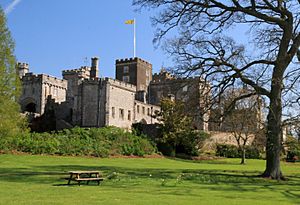Sir William Courtenay, 2nd Baronet facts for kids
Sir William Courtenay, 2nd Baronet (born March 11, 1676 – died October 6, 1735) lived at Powderham Castle in Devon, England. He was an important landowner and a leading politician from the Tory party. He served as a Member of Parliament (MP) in the English House of Commons and later the British House of Commons for many years, from 1701 until his death in 1735.
Who Was Sir William Courtenay?
Sir William Courtenay was the son of Colonel Francis Courtenay, who was also a Member of Parliament for Devonshire. His mother was Mary Boevey. Her family originally came from the Netherlands and were French Protestants known as Huguenots.
William's father passed away in 1699, before his own father, Sir William Courtenay, 1st Baronet. This meant that when his grandfather died in 1702, William inherited the title of Baronet and the family home, Powderham Castle. In 1704, he married Lady Anne Bertie, who was the daughter of James Bertie, 1st Earl of Abingdon.
His Political Journey
Sir William Courtenay began his political career by running for Parliament in Honiton in 1701. Although he didn't win that first election, he was soon elected without opposition to represent Devonshire later that same year.
He continued to be elected without anyone running against him in 1702, 1705, and 1708. He was a member of the Tory party, which was one of the main political groups at the time. In 1710, he stepped aside for another politician, but people wanted him back. So, he ran again in 1712 and won by a very large number of votes.
He was elected again in 1713 without opposition. From 1714 to 1716, he held an important position called Lord Lieutenant of Devon. This role meant he was the King's or Queen's representative in the county of Devon. He continued to be elected as an MP for Devonshire without opposition in 1715, 1722, 1727, and 1734.
His Family and Legacy
Sir William Courtenay passed away on October 6, 1735. He wanted to be buried in the north aisle of Powderham Church, near a monument that was already there. He also asked his nephew, William Courtenay, to spend money on building a new monument for him. However, no such monument exists today.
Sir William had many children, including:
- William Courtenay, 1st Viscount Courtenay
- Henry Reginald Courtenay, who also became an MP.
- Eleanor Courtenay (died 1765), who married John Francis Basset, another MP.
Records show that he had many other children, including Mary, James, Anna Sophia, Bridget, Isabella, Elizabeth, and Peregrine.
In his will, he left money to his nieces for mourning clothes and for diamond rings to remember him by. He also left money to his nephew, Sir William Courtenay, who received most of his remaining wealth.
Years later, in 1831, Sir William Courtenay was recognized as being the rightful 6th Earl of Devon.


